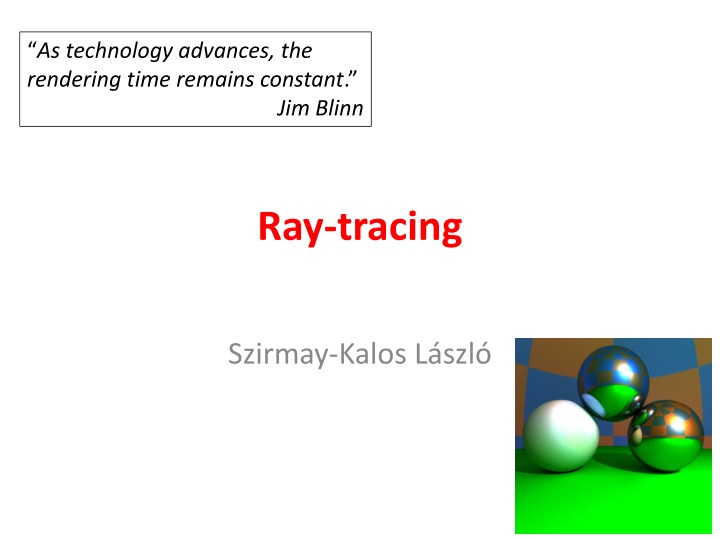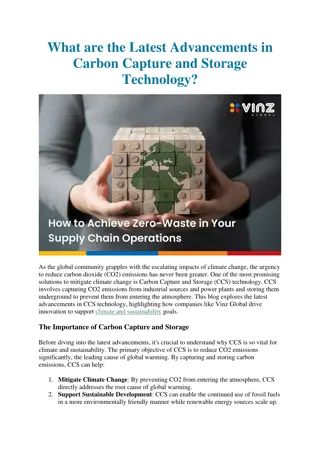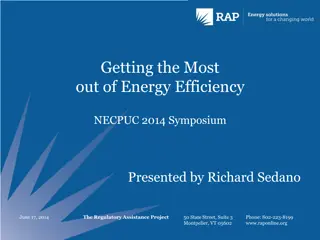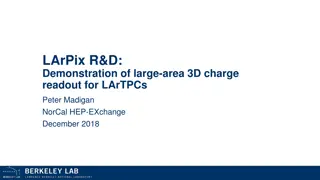Advancements in Technology and Rendering Time Efficiency
As technology progresses, rendering time remains constant in the field of computer graphics. Concepts like local illumination for rough surfaces and abstract light sources, ray-sphere intersection, and structuring of intersectable objects are discussed. The process involves ray tracing and handling of light sources to achieve realistic visual effects efficiently.
Download Presentation

Please find below an Image/Link to download the presentation.
The content on the website is provided AS IS for your information and personal use only. It may not be sold, licensed, or shared on other websites without obtaining consent from the author.If you encounter any issues during the download, it is possible that the publisher has removed the file from their server.
You are allowed to download the files provided on this website for personal or commercial use, subject to the condition that they are used lawfully. All files are the property of their respective owners.
The content on the website is provided AS IS for your information and personal use only. It may not be sold, licensed, or shared on other websites without obtaining consent from the author.
E N D
Presentation Transcript
As technology advances, the rendering time remains constant. Jim Blinn Ray-tracing Szirmay-Kalos L szl
Local illumination: rough surfaces, abstract light sources ?? pixel For each ??? abstract light source ???? ? ? ????? ??(?? ,?,?) cos+ ??? ?(?) Illumination of an abstract light source Directional = constant; Point = decreases with the square of the distance If occluded, zero
Local illumination: rough surfaces, abstract light sources pixel For each ?? abstract light source ?? ? ? ????? {?? (?? ?)++?? ((?? ?)+)? ???} ?(?) Illumination of an abstract light source Directional = constant; Point = decreases with the square of the distance If occluded, zero
GI Ambient term Local illumination + ambient term ????? ??(??,?,?) cos+ ???+ ?? ?? ?(?)
struct Ray { vec3 start; vec3 dir; // unit vector bool out; // outside? }; Visibility pixel struct Hit { float t; vec3 position; vec3 normal; Material* material; Hit() { t = -1; } }; ????? ???(?) = ????? + ??? ?, ? > 0 Hit firstIntersect(Ray ray) { Hit bestHit; for(Intersectable * obj : objects) { Hit hit = obj->intersect(ray); // hit.t < 0 if no intersection if(hit.t > 0 && (bestHit.t < 0 || hit.t < bestHit.t)) bestHit = hit; } if (dot(ray.dir, bestHit.normal) > 0) bestHit.normal *= -1; return bestHit; } Let it face towards us! if (N dir > 0) {N = -N}
Object = Intersectable struct Intersectable { Material* material; virtual Hit intersect(const Ray& ray) = 0; };
Ray - Sphere intersection |? ?|2= ?2 ? ? ? No root 1 root 2 roots ???(?) = ????? + ??? ? |???(?) ?|2= (????? + ??? ? ?) (????? + ??? ? ?) = ?2 (??? ???)?2+ 2((????? ?) ???)? + (????? ?) (????? ?) ?2= 0 Wanted: the smaller from the positive roots Only for sphere! Surface normal: ? = (??? ? ?)/?
struct Intersectable { Material* material; virtual Hit intersect(const Ray& ray)=0; }; Sphere as Intersectable class Sphere : public Intersectable { vec3 center; float radius; public: Hit intersect(const Ray& ray) { Hit hit; vec3 dist = ray.start - center; float a = dot(ray.dir,ray.dir); float b = dot(dist, ray.dir) * 2; float c = dot(dist, dist) - radius * radius; float discr = b * b - 4 * a * c; if (discr < 0) return hit; else discr = sqrtf(discr); float t1 = (-b + discr)/2/a, t2 = (-b - discr)/2/a; if (t1 <= 0) return hit; // t1>=t2 for sure hit.t = (t2 > 0) ? t2 : t1; hit.position = ray.start + ray.dir * hit.t; hit.normal = (hit.position - center)/radius; hit.material = material; return hit; } };
Implicit surfaces Surface points:? ? = 0 Ray: ???(?) = ? + ? ? Ray parameter or the intersection ? : ? ? + ? ? = 0 Intersection point: ? = ???(? ) = ? + ? ? Normal vector = ?? ? Quadratic surfaces: ? ? = ?,1 ? [?,1]?= 0 Ray parameter of the intersection: ? + ? ? ,1 ? [? + ? ? ,1]?= 0 ?,0 ? [?,0]?(? )2+ 2 ?,1 ? ?,0?? + ?,1 ? ?,1?= 0 Normal vector: ?? ? = ? [? ,1]?first three coordinates.
Triangle ? = (?? ??) (?? ??) ?? ?? ? ? ???(?) = ????? + ??? ? ?? ?? ?? (? ??) ? = 0 ?? ? =(?? ?????) ? ??? ? 1. Plane intersection: (???(?) ??) ? = 0, ? > 0 2. A metsz spont a h romsz g n bel l van-e? ((?? ??) (? ??)) ? > 0 ((?? ??) (? ??)) ? > 0 ((?? ??) (? ??)) ? > 0 Surface normal: ? or shading normals
Ray tracing: Render Virtual world: eye+window Real world: user+screen ray p eye Render( ) for each pixel p Ray r = getRay( eye pixel p ) color = trace(ray) WritePixel(p, color) endfor end p color
Camera: getRay YM up fov/2 lookat right eye Y p p X XM Normalized device coordinates p = lookat + right + up, = lookat + (2X/XM-1) right + (2Y/YM-1) up , in [-1,1] Ray dir = normalize(p eye)
-ray.dir = V trace N Lin yl ray N Ll r vec3 trace(Ray ray) { Hit hit = firstIntersect(ray); if(hit.t < 0) return La; // nothing [r, N,ka , kd , ks , shine] hit; vec3 outRad = ka* La; for(each light source l){ Ray shadowRay(r + N , Ll); Hit shadowHit = firstIntersect(shadowRay); if(shadowHit.t < 0 || shadowHit.t > |r - yl| ) outRad += } return outRad; } DirectLight () Shadow Lin *{kd (Ll N)++ks ((Hl N)+)shine} l
Homework 2: Luxo Grandpa Write a ray tracing program that renders a paraboloid lamp, planar table and arbitrary quadratic or polygonal objects on the table. A point light source is in the focal point of the paraboloid and casts shadows. In addition to the point source, the scene is illuminated by an ambient source. Objects can be diffuse-specular, or reflective or refractive.
Recursive ray-tracing Refraction ray ? ???? ? ?? ? ? Reflection ray Shadow ray DirectLight() ????? ?? ?? ?++ ?? ?? ?+? ??? ?(? ?) ???(?) + (1 ?(? ?)) ???(?) ? ? ?? ??+ Radiance from refraction direction Radiance from reflection direction 1-Fresnel Fresnel
trace V N yl vec3 trace(Ray ray) { ray Hit hit = firstIntersect(ray); if(hit.t < 0) return La; // nothing vec3 outRad(0, 0, 0); if(hit.material->rough) outRad = DirectLight(hit); Ll r if(hit.material->reflective){ vec3 reflectionDir = reflect(ray.dir,N); Ray reflectRay(r + N , reflectionDir, ray.out); outRad += trace(reflectRay)*Fresnel(ray.dir,N); } if(hit.material->refractive) { ior = (ray.out) ? n.x : 1/n.x; vec3 refractionDir = refract(ray.dir,N,ior); if (length(refractionDir) > 0) { Ray refractRay(r - N , refractionDir, !ray.out); outRad += trace(refractRay)*(vec3(1,1,1) Fresnel(ray.dir,N)); } } return outRad; }
trace V N yl vec3 trace(Ray ray, int d=0) { if (d > maxdepth) return La; Hit hit = firstIntersect(ray); if(hit.t < 0) return La; // nothing vec3 outRad(0, 0, 0); if(hit.material->rough) outRad = DirectLight(hit); ray Ll r if(hit.material->reflective){ vec3 reflectionDir = reflect(ray.dir,N); Ray reflectRay(r + N , reflectionDir, ray.out); outRad += trace(reflectRay,d+1)*Fresnel(ray.dir,N); } if(hit.material->refractive) { ior = (ray.out) ? n.x : 1/n.x; vec3 refractionDir = refract(ray.dir,N,ior); if (length(refractionDir) > 0) { Ray refractRay(r - N , refractionDir, !ray.out); outRad += trace(refractRay,d+1)*(vec3(1,1,1) Fresnel(ray.dir,N)); } } return outRad; }
Paul Heckberts business card typedef struct{double x,y,z}vec;vec U,black,amb={.02,.02,.02}; struct sphere{ vec cen,color;double rad,kd,ks,kt,kl,ir}*s, *best,sph[]={0.,6.,.5,1.,1.,1.,.9, .05,.2,.85,0.,1.7,-1.,8.,-.5,1.,.5,.2,1.,.7,.3,0.,.05,1.2,1.,8.,-.5,.1,.8,.8, 1.,.3,.7,0.,0.,1.2,3.,-6.,15.,1., .8,1.,7.,0.,0.,0.,.6,1.5,-3.,-3.,12.,.8,1., 1.,5.,0.,0.,0.,.5,1.5,};yx; double u,b,tmin,sqrt(),tan();double vdot(A,B)vec A ,B; {return A.x*B.x+A.y*B.y+A.z*B.z;}vec vcomb(a,A,B)double a;vec A,B; {B.x+=a* A.x;B.y+=a*A.y;B.z+=a*A.z;return B;} vec vunit(A)vec A;{return vcomb(1./sqrt( vdot(A,A)),A,black);}struct sphere *intersect(P,D)vec P,D;{best=0;tmin=1e30; s= sph+5;while(s-->sph)b=vdot(D,U=vcomb(-1.,P,s->cen)),u=b*b-vdot(U,U)+s->rad*s ->rad,u=u>0?sqrt(u):1e31,u=b-u> 1e-7?b-u:b+u,tmin=u>=1e-7&&u<tmin?best=s,u: tmin;return best;}vec trace(level,P,D)vec P,D;{double d,eta,e;vec N,color; struct sphere*s,*l;if(!level--)return black;if(s=intersect(P,D));else return amb;color=amb;eta=s->ir;d= -vdot(D,N=vunit(vcomb (-1.,P=vcomb(tmin,D,P),s->cen )));if(d<0)N=vcomb(-1.,N,black),eta=1/eta,d= -d;l=sph+5;while(l-->sph)if((e=l ->kl*vdot(N, U=vunit(vcomb(-1.,P,l->cen))))>0&&intersect(P,U)==l)color=vcomb(e ,l->color,color);U=s->color;color.x*=U.x;color.y*= U.y;color.z*=U.z;e=1-eta* eta*(1-d*d);return vcomb(s->kt,e>0?trace(level,P,vcomb(eta,D,vcomb(eta*d-sqrt (e),N,black))): black,vcomb(s->ks,trace(level,P,vcomb(2*d,N,D)),vcomb(s->kd, color,vcomb(s->kl,U,black))));} main(){printf("%d %d\n",32,32);while(yx<32*32) U.x=yx%32-32/2,U.z=32/2-yx++/32,U.y=32/2/tan(25/114.5915590261), U=vcomb(255., trace(3,black,vunit(U)),black),printf("%.0f %.0f %.0f\n",U);}/*minray!*/
OO decomposition Material n, kappa ka, kd, ks, shine reflective refractive rough Scene La build() render() firstIntersect() trace() heterogeneous collection Intersectable Hit intersect() reflect() refract() Fresnel () shade() objects Sphere center, R intersect() Mesh Camera eye, lookat, up, right, XM,YM getRay() Light p, Lout, type getLightDir() getInRad() getDist() intersect() CPU GPU CPU GPU























